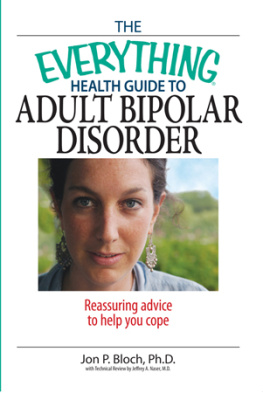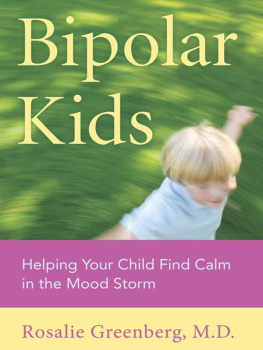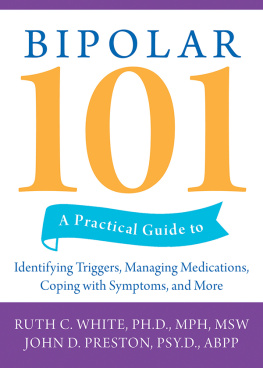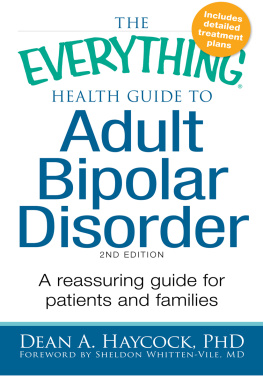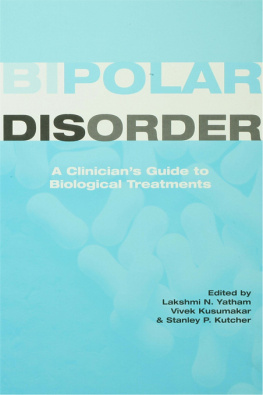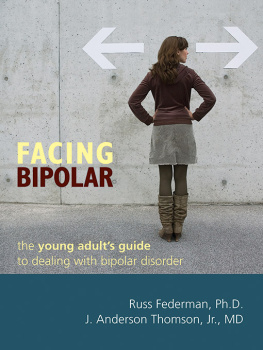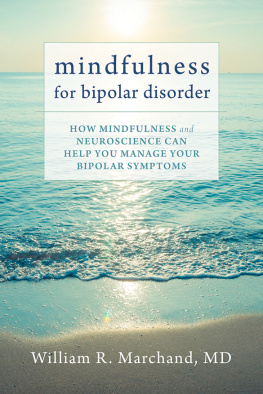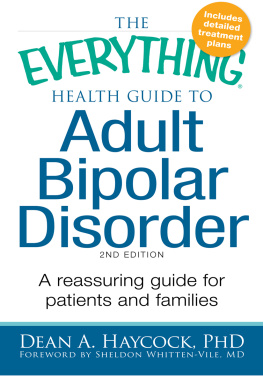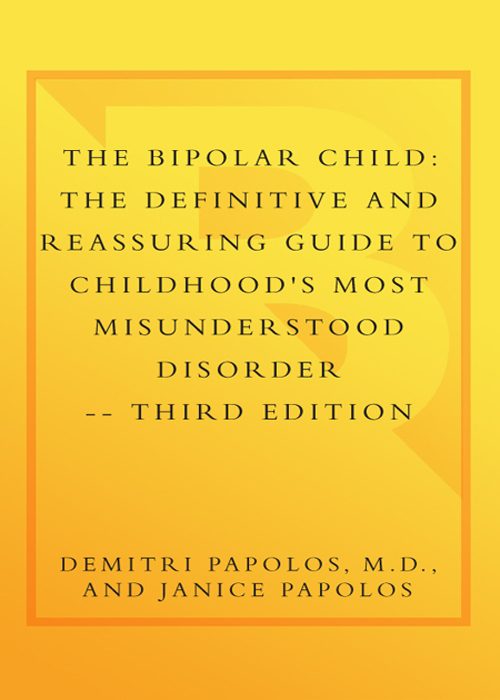
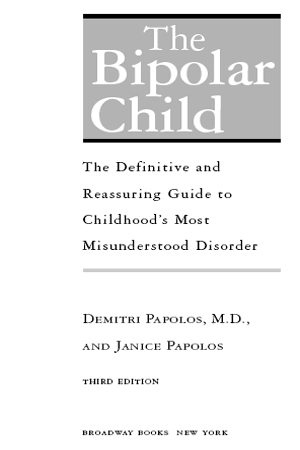
Contents
For
Alex and Jordy,
and for
all the children
Preface to the Third Edition
It is hard to believe that six years have passed since this volume first appeared on bookshelves. When it was launched in January of 2000 with a segment on 20/20, it was the first time that the phrase early-onset bipolar disorder had ever been mentioned in prime time. The reaction was surprising even to our publishers.
Over six thousand people joined us online for a chat after the airing of the show, and thousands more e-mailed ABC and our website over the next few days. Many wrote that they sat stunned on the sofas of their living rooms as they learned that their childrens wild and erratic behaviors had a name. Their children had an illness. They had not been acting volitionally; the parents themselves were not inadequate.
Since that night in 2000, much has changed to ease the burden of the children and families, and when our editor, Gerald Howard, asked us to consider another revision of the book, we felt extremely gratified to have a third opportunity to keep our readers abreast of all the advances. Let us outline some of the additions weve made to The Bipolar Child, Third Edition.
The first step to mood stabilization is finding the right treatment strategy for each child. In Chapter 4, Prescriptions for Treatment, weve underscored the impact of seasonal change on the course of the illness. It has long been established that adult patients with bipolar disorder have pronounced seasonal episodes that require increased vigilance during these times of vulnerability and, commonly, medication adjustments. This is no less true for children. Mothers on Internet bulletin boards have dubbed these seasonal perturbations March madness and September slumps.
These challenges to stability must be taken into account, or the childs previously stabilized mood may begin to disintegrate with the change of day/light and temperature cycles. If modifications are made to the medication regimen prior to these seasonal changes, destabilization might be staved off, ensuring a smoother, more grounded year for the child or adolescent.
In the previous editions of this book, we sounded an alarm about the dangers of antidepressant treatment for children with bipolar disorder. We observed (and parents reported) emerging manias, increased aggression, psychosis, and suicidal thoughts and behaviors after treatment with these drugs. Although formal studies were scarce, parents reported this phenomenon to us in overwhelming numbers. We went ahead and issued the warnings.
On October 15, 2004, the Food and Drug Administration issued a public health advisory to warn the public about the increased risk of suicidal thoughts and behaviors in children and adolescents being treated with antidepressant medications. The agency ordered manufacturers to add a black box warning to the professional labeling of all antidepressant medications to describe the risk and emphasize the need for close monitoring of young patients started on these medications.
Stimulants also can produce similar symptoms and behaviors in this population of children and adolescents, and again, we want to urge caution and careful monitoring. Although these medications are short-lasting, they are not always benign drugs for many youngsters with bipolar disorder.
On a brighter note, Chapter 4 includes a discussion of a new test that can locate an allele pattern in a childs genetic makeup that can gauge how quickly he or she will metabolize certain psychotropic medications. This test, and others in development, will no doubt prove very helpful to clinicians as they can make more informed treatment decisions that may reduce adverse side effects and improve treatment outcomes. (Major advances in molecular genetics are explained in some depth in Chapter 5, The Genetic Aspects of Bipolar Disorder.)
Second only to the complexity of diagnosis and the medical treatment of juvenile bipolar disorder is the piece of the puzzle called school. With the reauthorization of the Individuals with Disabilities Improvement Act of 2004 (and its enactment in 2005), so many changes have been made to the laws governing special education that we have completely revised and expanded Chapter 9, School: A Childs World Beyond Home. The information in this chapter will educate parents about the new laws that will impact their children in the academic setting and will help them work with their school systems to ensure that their sons and daughters receive a free and appropriate education. A new Individualized Education Plan (IEP) has been added, as well as lists of accommodations that might be added into the IEP. These accommodations are divided into four categories: those that might be needed as a result of the symptoms of the illness, the side effects of the medications, attentional problems, and specific learning disabilities.
Weve also added sample letters to this chapter: one that will help parents request a complete evaluation of their child and another that will help parents personally introduce their child to nonspecial education teachers in order to spotlight the childs special gifts and needs in a warmer, less formal way. It is our hope that this kind of connecting will help strengthen the alliance between parents and teachers and make the student more comfortable in the school environment.
Chapter 10 is called The Neuropsychological Testing of a Bipolar Child. The jumping-off point for neuropsychology is a test of general intellectual ability, and the Wechsler Intelligence Scales for Childrenthe WISC-IIIhas heretofore been the most commonly administered IQ test. The WISC-III has now been replaced by the WISC-IV, and we explain the battery of new subtests and what specific aspects of cognitive functioning they measure. This test and the other neuropsychological tests detailed in this chapter will bring to light the strengths and weaknesses of a student and guide accommodations and remediation strategies.
Also included in this chapter is a discussion of the difficulties many children and adolescents with bipolar disorder experience when asked to produce written work in the form of essays or expository writing. These common, co-occurring deficits of written expression render homework assignments a nightmare for the student and an agony for the parents who must supervise the work and attempt to motivate the balky child. We hope this new understanding of how difficult it is for these students to write in essay form will help take the onus off of the parents and help make it possible for them to work closely with the school system to modify the work and remediate the problem.
We have always felt that Chapter 8, The Impact on the Family, was the heart and soul of this book. We have expanded its pages considerably to include many common but often unrecognized behaviors that come hand-in-hand with the illness and that have a profound impact on the interactions of the child with all of the family members.
Many of these children simply cannot get up in the morning (they suffer sleep inertia), and Monday through Friday mornings devolve into a battleground as parents urgently try to pull their children out of bed and get them off to school. In addition, these children and adolescents can be relentless in the pursuit of their own agendaswearing down the parents in the process (one mother coined the phrase mission mode for this behavior). Moreover, these youngsters are often bored and subsequently become very provocative (often with siblings) in order to relieve these intolerable periods of boredom. These discussions should help parents better understand what is driving the youngsters and how to better deal with and to modify the behaviors.
Next page

